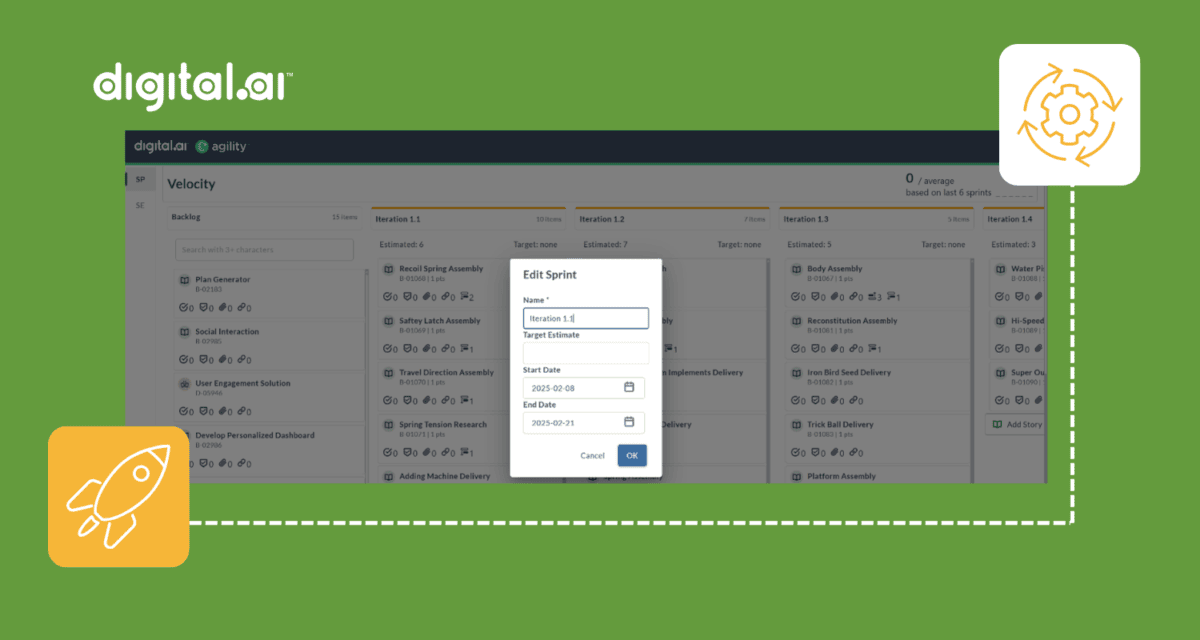Table of Contents
Related Blogs
A team is the core unit of productivity in an organization using agility. Whereas traditional waterfall organizations may rely primarily on managers or departments to control the pace and quality of work, agile organizations get work done through teams.
Properly structured and motivated, an agile team can accomplish product-related goals with speed — and with minimal levels of needed input or supervision. The Agile Manifesto even states: “The best architectures, requirements, and designs emerge from self-organizing teams.”
However, teams don’t automatically self-organize unless the right culture and conditions are in place. In other, words, agile leaders can’t just throw teams together and expect to obtain the promised level of effectiveness. Instead, a combination of adept recruiting, well-defined guardrails, a culture of enablement, and a strong top-down vision must be implemented to ensure agile teams can align with one another and with overall organizational objectives. Of these, culture and recruiting can be the most intrinsically important since certain traits determine how well an agile team will perform.
- To be as effective as possible, a good agile team should exhibit the following qualities:
- Cross-functional capabilities
- Intuitively understands what is needed, even in the face of ambiguity
- Thorough knowledge of customer needs and what works best for the product
- Thrives in a collaborative, cooperative environment
- Self-reflective and self-aware
Effective cross-functional agile team norms & capabilities
In waterfall organizations, team units involve groups of people with redundant skillsets: a “team” of accountants isn’t so much a team as it is a pool of workers to delegate tasks to. Everyone on the team divides work amongst themselves, and a manager provides instructions and oversees results. Each waterfall team unit is intended to be capable of accomplishing a specific task with minimal latency, similar to a purpose-built machine on an assembly line.
The unfortunate consequence of the waterfall-era team unit is that tasks are only performed at-speed within the team itself. Any handoffs or complications that require the skills of someone outside the team will lead to delays in task fulfillment. Further, teams will often lack a vision or purpose behind their work. This is critical because many product innovations and improvements are directly sourced from a team’s own intuitions.
To this end, agile teams are built from skill-diverse groupings capable of handling nearly any task. Like the A-team or the Avengers, each member is capable of performing most basic tasks adeptly, but each also possesses specialized skills and expertise, which are applied to unique challenges and situations. This is the concept behind cross-functional teams: they are prepared to handle any task with minimal dependency on direct management or assistance from outside teams.
“An effective agile team has all the skills needed to develop small increments of value in a short, fixed period of time,” asserts Digital.ai Vice President Richard Knaster in his recent eBook, Value Stream Management for the Digital Age. “Consequently, assigning work to individual team members should no longer be required, as teams are primarily self-managing. This team structure fosters autonomy, decentralized decision-making, and execution.”
By limiting inter-team dependencies, cross-functional teams are capable of completing most work items autonomously. In the event they do require outside resources, they are more likely to follow through with the outcome rather than simply handing off the work item and expecting it to be completed as intended. This arrangement effectively smooths out bottlenecks and reduces hand-offs while fostering a culture of independence, where seeing work items through to their end goals is the norm.
Agile team key behaviors
In addition to cross-functional capabilities, members of effective agile teams should possess the following desirable qualities:
Intuitively understands what is needed, even in the face of ambiguity
Agile organizations entrust in the skillsets of their individual workers and the teams they are on. This means that, unlike waterfall management, there is no need for extremely explicit instructions, micro-management, or over-explaining of task requirements. Work items are less repetitive in nature, but they involve the completion of tasks that make the most of the team’s collective skillsets.
Since agile teams are supposed to be highly familiar with their products and knowledge domains, they will, in most cases, have more intimate knowledge of how to complete a task compared to anyone else in the organization.
A primary benefit to being able to intuit the requirements of a given task is that teams don’t cause delays by repeatedly requesting specific details and information. They are self-organizing in the face of such a task, and even when requesting information, they are capable of inputting suggestions for how the goal might be accomplished.
It’s no surprise, then, that when McKinsey surveyed effective agile teams, the number one most important quality/skill they cited was the ability to handle ambiguity.
According to McKinsey’s corresponding report: “Teams that handle ambiguity well mainly focus on their goals and prioritize few items to get started instead of investing a significant amount of time to completely understand every single detail and risk and attempting to embed these into the plan.”
Teams with these capabilities not only lower startup times on task groupings but also bring their ideas and expertise to the table to accomplish goals using the full extent of their knowledge and skills. These agile team qualities allow the team to translate basic requirements into fully realized deliverables with value-added qualities.
Thorough knowledge of customer needs and what works best for the product
As previously alluded to, effective agile teams are the experts when it comes to their domains within the product ecosystem. Product owners are the drivers of customer-centered priorities within a specific value stream, but the agile teams themselves should have an innate understanding of which feature groups and task flows are considered most important by the customer base.
Overall, each team works in coordination with the product owner to develop the best product possible, based on the team’s skills and understanding. This relates to the work value-effective agile teams reported as most important to McKinsey: “Pride in Product”
“For them, pride in the product (the outcome) sits higher than pride in the work (the process): they know that the process can and will change as they review the relationship between the process and the value it achieves. Being proud means more than being happy with the work; it also means wanting to be associated with the product and taking ownership of its values and contributions”
Pride in product motivates teams to consider outside factors and not just meet the bare minimum deliverables. Pride in the product also drives productivity, problem-solving, and proactive follow-through when coordinating with other teams. It becomes a huge factor in having teams steer the direction of the product towards the best version of itself it can be.
Thrives in a collaborative, cooperative environment
Unlike single-discipline waterfall teams, where sharing work is often seen passing the buck and collaborative work is seen as an exception to the norm, Agile teams thrive in a cooperative environment. Teammates are eager to contribute and also to work in coordination with one another to achieve goals. These agile team key behaviors don’t manifest automatically; they have to be part personality-driven and part-driven by the overall work culture
To that end, McKinsey’s survey revealed that “agreeableness” and “conscientiousness” were both desirable personality traits. Neuroticism — or the quality of getting easily flustered, irritated, or distracted when challenges emerge — was seen as the least desirable trait.
Being on a team requires some degree of emotional intelligence, too. This means that team members “show respect toward their colleagues, motivate each other, and support the personal growth and success of each team member,” according to the AgileConnection community. “They are aware of the differences that can exist when working with teammates of varying backgrounds. These teams have worked on acquiring skills to handle situations more effectively, and that shows up in their work.”
Self-reflective and self-aware
Retrospectives are a critical part of the cyclic agile process. They entail evaluating what worked and what didn’t while also reflecting on ways to improve. Suggested responses drive processes and products towards improved future outcomes. Reflection also has the effect of paving over past mistakes (or even team-based shortcomings) through a commitment to adapt and improve.
“When they can review with fresh minds what factors caused them to underachieve, the team grows with confidence knowing they will do better,” states one agile resource. “This team will evaluate, assign and resolve the facets of development which caused them to underachieve. A remarkable Agile team will always seek knowledge and follow a process to gain this knowledge.”
In the most effective agile teams, being self-reflective doesn’t just happen in the retrospective stage, though. It happens in the early stages of work, too, especially with sprint planning and priority management. These teams will focus on business value and reducing factors that limit sprint velocity or release quality.
As an example, the employee recognition firm Achievers says that “the teams that are successful have a habit of keeping the focus on a limited number of tasks like a hawk. Their Work-In-Progress limit is extremely low. Like bees, they practice swarming. They finish what they start before picking up new tasks by having many people work on single tasks at the same time rather than going through a series of hand-offs.”
Alignment with goal outcomes can also mean that engineering teams will build features and releases with testing firmly in mind. Also per Achievers: “Developers should always think before they write one line of code. This high-performance, remarkable Agile team thinks deeply about the design and expected outcome of the feature or story before writing any code. This team also believes that their design will be better if they look at how the feature or story should be tested. This is the motivation behind writing tests first.”
Due diligence and self-awareness also mean that teams are committed to the agile version of the Scout camping rule: “always leave code better than you found it.”
Overall, the ability to maintain awareness of what factors contribute to or detract from successful outcomes guides a team like a constellation in the sky — pointing them towards a destination, rather than through a series of tasks in succession with no end vision in mind.
Learn more about pushing your company’s agile culture forward in our white paper: “Value Stream Management for the Digital Age”
These are just some of the factors that go into building a successful agile organization. Teams are the building block, but they need some level of vision, structure, and guidance to keep them aligned towards business and customer value.
Learn the factors that can help organizations succeed in accomplishing continuous value delivery in our white paper: “Value Stream Management for the Digital Age“
Are you ready to scale your enterprise?
Explore
What's New In The World of Digital.ai
Digital.ai and Packaged Agile Partner to Help Enterprises and Agencies Reclaim the Value of Agile
Digital.ai and Packaged Agile: A Strategic Partnership That Reconnects Agile Delivery with Real Business & Mission Outcomes to be More Efficient & Effective
Plan, Execute, and Measure – All in One Environment: Digital.ai Agility 25.0 Feature Announcement
Discover what’s new in Digital.ai Agility 25.0 – updates to Rooms 2, OKR management, and more!
Better Together: Unlocking Endless Possibilities For Our Customers
This Valentine’s Day, join us in celebrating the unique stories that make our Digital.ai customers special!




